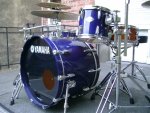Apart from matters of sheer taste, the answers are not so simple.
Because sometimes a gig or a studio session requires such muffling. Its not at the demand of a crappy soundman either. I have had engineers or artists I'm doing a session for request a more muffled kick that is quick and tame. Fair enough, its his song, its what he wants. Who am I to argue and say my kick sounds better empty?
Too many of us preach open kicks, unmuffled snares and toms. Sometimes the job just doesn't require such techniques.
Much truth here. I will say that I've noticed that more sound guys--both live and in the studio--are open to a more resonant sound these days, but you're doing a job and you're not in charge of tone.
However: many drummers don't realize the difference in requirements for miked vs. unmiked. When you're miked you can expect to be using some muffling, or premuffled heads, a port in the reso, and JAW tuning.
But I see many drummers playing a bass drum set up like this in the live unmiked situation, too. Sounds perfectly fine from the driver's seat, but I bet most of them don't know that their bass drums are nearly inaudible.
For unmiked you definitely need sustain--it's what gets you heard. You hear the sustain at the kit but the audience doesn't--they just hear a louder bass drum.
My setup for unmiked is PS3s front and rear, no port, and nothing in the drum. Reso tuned up above JAW a little, up to where it begins to sustain. Batter tuned a smidge higher.
I would never expect that setup to work well under the mikes, either live or (especially) in the studio. But if you're playing out unmiked, no one will hear your bass drum otherwise.
You know these:
http://images.static.steveweissmusic.com/products/images/uploads/popup/REM-MF-1008-00.jpg
They muffle the kick enough so you don't need a pillow. By keeping the kick empty, you don't lose volume. At least my empty kick with emad sounds like a cannon. So far so good.
Well, no. Muffling = softer. That's why they call it muffling. Doesn't matter if the muffling is a futon in the drum or foam sticking to the head. It will sound different than with a pillow, but it will cut volume all the same.
That's not an issue when miked, obviously.
The point is (as PRF alluded to), different situations call for different approaches to muffling and tuning. There is no one-size-fits-all solution. You can be a purist all you like in the practice room, but when you're on a gig you need to give what your employer wants.
I play unmiked all the time, while the kid plays mostly unmiked, but not always. If we're not sure about whether the drums will be miked we take two resos to the gig, one ported and the other unported, along with an Evans EQ pad and a rolled-up towel for muffling. A little tweaking of the tuning and you have one drum for both sounds.
that makes me look into the old fashioned powerstroke3 with foam muffle.
Just FYI, the PS3 has no foam ring, just a "control" ring of head material around the perimeter.
Finally, after all these years, I still like the sound of felt strips for muffling. They are adjustable in effect and fully removable. Win-win.


